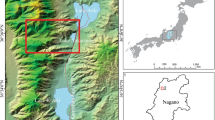Abstract
The sediments of Loe Pool, a eutrophic coastal lake in south west England, consist largely of laminated clays and clay-gyttjas. Studies of the diatom microstratigraphy of frozen sediment cores from the Pool indicate that the laminations are annual, and that they contain pairs of light and dark bands formed by seasonal variations in the supply of sediment to the Pool from its catchment. Analysis of the magnetic properties of individual laminations demonstrates the presence of physical and mineralogical microstratigraphic variations, which may also be related to seasonality.
A varve chronology, which is confirmed by 137Cs analysis and historical records, has been used to provide a timescale for the interpretation of data from other paleolimnological studies. A close agreement between variations in the abundance of sedimentary Sn, and the history of mining in the catchment, has been found. Similarly, analysis of total organic matter, total phosphorus, sedimentary chlorophyll a, sterols, diatoms and Cladocera in the uppermost sediments all indicate eutrophication of the Pool in the period AD 1940 to the present.
Similar content being viewed by others
References
Frey, D. G., 1979. Cladocera analysis. In: B. E. Berglund (Ed.) Paleohydrological changes in the Temperate Zone in the last 15 000 years: Lake and Mire environments. Vol. 2, Specific methods. IUGS, UNESCO project No. 158B, Lund, Sweden.
Gaskell, S. J. & Eglinton, G., 1976. Sterols of a contemporary lacustrine sediment. Geochim. Cosmochim. Acta, 40: 1221–1228.
Hamilton-Jenkins, A. K., 1978. Wendron Tin. Wendron Forge, Wendron, Cornwall, U.K.
Huang, W. Y. & Meinschein, W. G., 1979. Sterols as ecological indicators. Geochim. Cosmochim. Acta 43: 739–745.
Huttunen, P. & Merilainen, J., 1978. New freezing device providing large, unmixed sediment samples. Ann. Bot. Fenn. 15: 128–150.
O'Sullivan, P. E., Coard, M. A. & Pickering, D. A., 1982. The use of laminated lake sediments in the estimation and calibration of erosion rates. In: Recent Developments in the Explanation and Prediction of Erosion and Sediment Yield (Proceedings of the Exeter Symposium, July 1982) IAHS Publ. No. 137.
Pennington, W., Cambray, R. S. & Fisher, E. M., 1973. Levels of 137Cs in British lake sediments. Nature 242: 824–826.
Simola, H., 1977. Diatom succession in the formation of annually laminated sediment in Lovojärvi, a small, eutrophicated lake. Ann. Bot. Fenn. 14: 143–148.
Simola, H., Coard,M. A. & O'Sullivan, P. E., 1981. Annual laminations in the sediments of Loe Pool, Cornwall. Nature 290 (5803), 238–241.
Vallentin, R., 1903. Observations on the plankton of Loe Pool. J. Roy. Inst. Cornwall 15: 328–345.
Author information
Authors and Affiliations
Rights and permissions
About this article
Cite this article
Coard, M.A., Cousen, S.M., Cuttler, A.H. et al. Paleolimnological studies of annually-laminated sediments in Loe Pool, Cornwall, U.K.. Hydrobiologia 103, 185–191 (1983). https://doi.org/10.1007/BF00028450
Issue Date:
DOI: https://doi.org/10.1007/BF00028450




